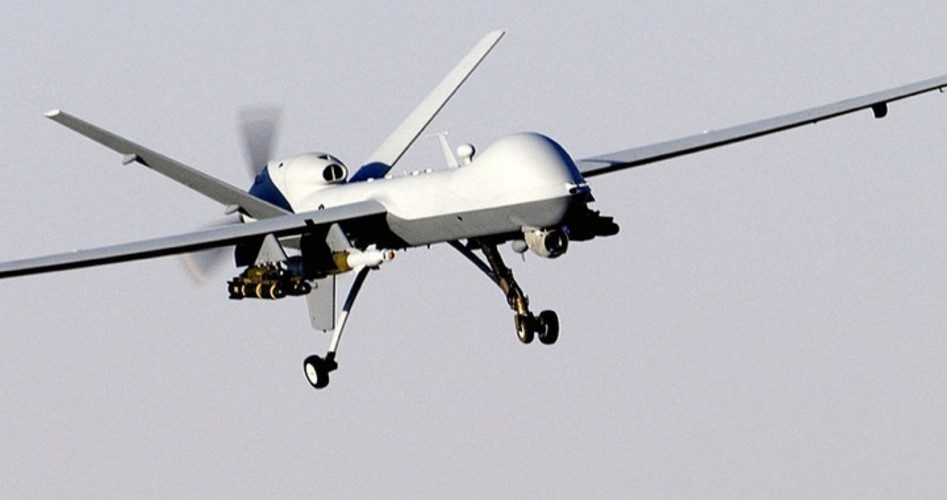
The U.S. Department of Defense, beginning in 2006, and continuing up through at least 2015, have made multiple uses of unmanned drones to conduct surveillance missions — spying — above the soil of the country.
According to a report, “Evaluations of DoD Use of Unmanned Aircraft Systems (UAS) for Support of Civil Authorities,” the inspector general of the Defense Department found that while “less than 20” such missions had occurred during that time, they expect there will be many more in the future.
The report insists, however, that the missions were conducted within “full compliance” of existing law.
A reading of the inspector general’s report reveals that the Pentagon views these missions as good ways to train their pilots. “As the nation winds down” wars in Afghanistan and Iraq, the pilots have fewer “opportunities for UAS realistic training.” With such fewer opportunities in foreign wars, these spy drones can now be used inside the borders of the United States.
In fact, the report said there is an “appetite to use them in the domestic environment.”
Jay Stanley, a senior policy analyst for the American Civil Liberties Union (ACLU) expressed concern. “Sometimes, new technology changes so rapidly that existing law no longer fit what people think are appropriate.”
The Defense Department policy governing the use of these spy drones presently mandates that the secretary of defense personally sign off on all such use. The policy provides that unless the law allows such surveillance, the drones may not spy on U.S. persons.
Apparently, not all requests for using drones to conduct surveillance were approved. The report cites an unnamed mayor of an unnamed city who actually asked the Marine Corps to use a drone to locate potholes. The Marines declined to do so, remarking it “did not make operational sense.” One might also ask, “If a city cannot even fix a pothole without calling in the Marines, just exactly what can they do?”
There are two types of unmanned aerial vehicles (UAVs) or drones used by the Pentagon, at this time. One is the MQ-1B Predator, which weighs 1,130 pounds. The other is the MQ-9 Reaper, a much larger drone, which weighs almost 5,000 pounds.
While the use of these drones by the military, for domestic use, have so far been used for benign purposes (so far as we know), it is quite clear that the precedent has been set for the expansion of their use. As the report itself states, there is an “appetite” to use these drones for domestic use.
Their use also raises other legal questions. With the controversial provisions of the National Defense Authorization Act (NDAA), which allow detention for alleged terrorists captured on American soil, combined with military drones used in domestic actions, one could make the case that the soil of the United States could be seen as much a “battle field” in the “War on Terror” as faraway places as Afghanistan and Iraq. As such, due process of law restrictions, which restrict the activities of domestic law enforcement, state and federal, could be argued to no longer apply. One must remember that simply because a person is accused of having committed a crime does not mean the person actually did commit a crime. But, if these spy drones are used by the military to aid domestic law-enforcement agencies — or even conduct such operations on their own — then the line between military action and law-enforcement action has certainly been crossed.
In the aftermath of the American Civil War, the military was used by the federal government to enforce federal laws in the defeated Southern states. This period of time, known as Reconstruction, was a time in which constitutionally protected civil liberties were often ignored by the Grant administration.
Then, in 1876, the Republican candidate for president, Rutherford Hayes of Ohio, lost the popular vote to the Democratic candidate, Samuel Tilden of New York. Hayes clearly had 165 electoral votes, and Tilden clearly had won 184 electoral votes. Twenty electoral votes were in dispute, because three Southern states had turned in two sets of competing election returns — one showing Hayes winning and one showing Tilden winning. An Electoral Commission created by Congress to settle the dispute awarded all disputed votes to Hayes, making him president by one vote.
This threatened a second civil war, this time between the two political parties. An agreement was finally reached to allow Hayes to take office as president, in exchange for Hayes promising to withdraw federal troops from occupation of the former Confederate states.
No longer could the military be used in domestic law enforcement. The agreement was codified when President Hayes signed a bill into law in 1878, known as “Posse Comitatus.” In short, the law restricts the U.S. Army. After an amendment in 1956, it also places the same limitations upon the U.S. Air Force. Legal experts contend the law would effectively place such restrictions upon the U.S. Navy, as well.
It seems clear that the use of military drones to “assist” either federal law-enforcement agencies (such as the Federal Bureau of Investigation or the Bureau of Alcohol, Tobacco, and Firearms) or state law enforcement is simply not legal.
Steve Byas is a professor of history at Hillsdale Free Will Baptist College in Moore, Oklahoma. His book, History’s Greatest Libels, is a challenge to some of the lies of history told against such persons as George Washington, Thomas Jefferson, and James K. Polk.



